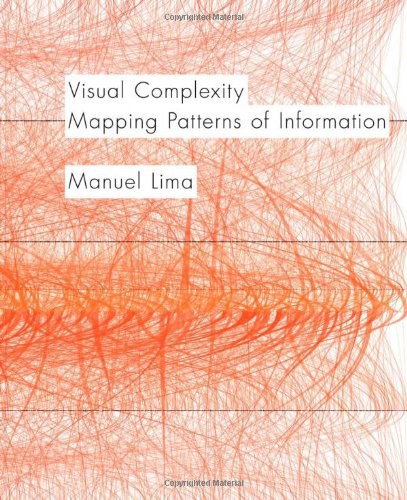
书名:Visual ComplexityMappingPatternsofInformation
作者:ManuelLima
译者:
ISBN:9781568989365
出版社:PrincetonArchitecturalPress
出版时间:2011-10-18
格式:epub/mobi/azw3/pdf
页数:272
豆瓣评分: 8.6
书籍简介:
Our ability to generate information now far exceeds our capacity to understand it. Finding patterns and making meaningful connections inside complex data networks has emerged as one of the biggest challenges of the twenty-first century. In recent years, designers, researchers, and scientists have begun employing an innovative mix of colors, symbols, graphics, algorithms, and interactivity to clarify, and often beautify, the clutter. From representing networks of friends on Facebook to depicting interactions among proteins in a human cell, Visual Complexity presents one hundred of the most interesting examples of information-visualization by the field's leading practitioners.
作者简介:
Manuel Lima是世界顶级信息可视化的布道者,他建立的网站VisualComplexity.com是当今最有影响力的信息可视化图库之一.他曾任微软必应产品用户体验部的高级设计主管,是Royal Society of Arts 会员,被美国Creativity杂志评为“2009年最具创新性和影响力的50个人物”.他经常在世界范围内的技术大会上演讲,如TED、Lift、OFFF、Reboot、VizThink、IxDA Interaction等,还在各类高等院校举办讲座,如Royal College of Art、NYU Tisch School of the Arts、ENSAD Paris、University of Amsterdam、MediaLab Prado Madrid等.译者简介杜明翰求学于丹麦哥本哈根、上海同济,敲着代码、画着图也开着咖啡厅,更愿意是一个会创造的desigineer(designer+engineer).现于创新工场专注体验设计与产品咨询.着迷服务设计、产品设计、媒体艺术等.个人网站:minghan.me.陈楚君美国卡耐基梅隆大学信息设计在读研究生,中山大学传播与设计学院毕业.做过实习记者、媒体策划,但更热衷于在各种类型的非营利组织做设计和翻译.感兴趣的领域包括信息设计、用户体验、设计教育和社会创新等.个人网站:joychen.info.
书友短评:
@ 洛奇 最大的惊奇是发现前老板早年的一个作品被此书收录。 @ catye 案例不错 @ Ikkun_kun network @ 卡罗尔是尖尖 I saw the author yesterday. He is really handsome and awesome. He graduated from DT some years ago. @ Joan http://www.visualcomplexity.com/ ||图研所 http://datemap.diandian.com @ 洛奇 最大的惊奇是发现前老板早年的一个作品被此书收录。 @ makzhou 很用心的一本书(收集了各种可视化的例子,从历史的到当代的),适合冥想。但在漂亮之外,此类数字人文项目依然没有能够说服整个学科:象征性的意义可以被具体化的图和表进行表达吗?「意义/价值空间在现实世界的投影」能带我们走多远? @ 木又 除了信息可视化的历史以外,第五章归纳的15种类型的信息图表达方法非常有洞见/看完Information Graphics,来把评价改成五星/捂脸。如果说IG一书是一本大而全的以Alphabet的结构组织的案例汇总,里面的案例信息的罗列与抽象兼有的话,VC一书则把重点聚焦在了更为深入与抽象的 信息的关系的可视化上,并总结出了15种基本的信息结构 @ 逛逛 殿堂级的信息可视化奠基类书,原汁原味 @ Ikkun_kun network
The book is divided in seven chapters and I like to think of it almost as a symphony, with the first three chapters providing a foundational opening for the lavish visual burst of chapters 4 and 5 – the sonata’s allegro or vivace – immediately followed by its final cadence, “Complex Beauty” (perhaps my favorite chapter) and “Looking Ahead”. Here’s a bit on the book’s structure, as explained in the Introduction:
01 | The Tree of Life
The book opens with “Tree of Life,” an exploration of the sacred meaning of trees and their widespread use as a classification system over the centuries. It showcases an assortment of ancient representations — as predecessors of modern-day network diagrams — where the tree metaphor is used to visually convey a variety of topics, from theological events to an encyclopedia’s table of contents.
02 | Form Trees to Networks
The second chapter, “From Trees to Networks,” makes the case for a new network-based outlook on the world, one that is based on diversity, decentralization, and nonlinearity. It explores several instances — from the way we envision our cities to the way we organize information and decode our brain — where an alternative network model is replacing the hierarchical tree schema.
03 | Decoding Networks
Chapter three, “Decoding Networks,” delves into the science behind network thinking and network drawing, providing a short introduction to its main precursors and early milestones. It also takes a pragmatic and utilitarian look at network visualization, acknowledging its key functions and proposing a set of guiding principles aimed at improving existing methods and techniques.
04 | Infinite Interconnectedness
Following a series of functional recommendations for network visualization, chapter four, “Infinite Interconnectedness,” presents a large number of examples divided into fourteen popular subjects. From depictions of the blogosphere to representations of terrorist networks, chapter four highlights the truly complex connectedness of modern times.
05 | The Syntax of a New Language
If chapter four looks at the practice primarily through its most common themes, chapter five, “The Syntax of a New Language,” organizes a vast array of projects by their shared visual layouts and configurations. As designers, scientists, and researchers across the globe portray an increasing number of network structures in innovative ways, their collective effort forms the building blocks of a new network-visualization lexicon.
06 | Complex Beauty
After presenting an abundance of network-visualization examples in chapters four and five, chapter six, “Complex Beauty,” examines the alluring nature of networks, responsible for a considerable shift in our culture and society. Alternating between scientific and artistic viewpoints, this chapter explores the divide between order and complexity before culminating in a discussion of an original art movement embracing the newly discovered beauty of the network scheme.
07 | Looking Ahead
Finally, and in the spirit of network diversity and decentralization, “Looking Ahead,” the last chapter, presents different views on the influential growth of visualization, according to renowned experts, active participants, and attentive observers. The featured essays cover an array of trends and technologies shaping the progress of visualization and provide an immensely captivating perspective on what may lie ahead.
· · · · · ·
添加微信公众号:好书天下获取
 好书天下
好书天下
评论前必须登录!
注册